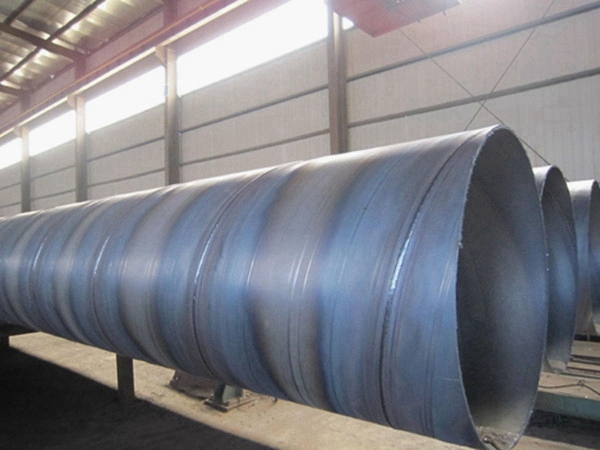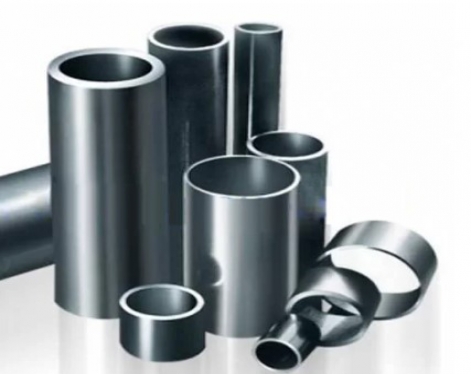SSAW steel pipes is made of strip steel coil as raw material, often warmly extruded, and welded by automatic double-wire double-sided submerged arc welding process, which belongs to a kind of welded pipe.
SSAW steel pipe should be tested for mechanical properties, flattening and flaring before leaving the factory, and should meet the requirements of the specification rules. The quality inspection methods are as follows:
1. Judging from the appearance, that is, the appearance inspection. The appearance inspection of welded joints is a simple and widely used inspection method. It is an important part of the inspection of finished products, mainly to find defects and deviations in the appearance of welds. Generally, it is checked with the naked eye and with standard templates, gauges and magnifying glasses. If there is a defect on the outside of the weld, there is a possibility of a defect inside the weld.
2. Physical inspection: The physical inspection method is a method of measuring or inspecting by using some physical phenomena. The inspection of the internal defects of materials or workpieces generally adopts the method of non-destructive testing. Non-destructive testing includes ultrasonic testing, radiographic testing, penetration testing, magnetic testing, etc.
3. Strength test of pressurized container: In addition to the tightness test, the strength test is also required for the pressurized container. There are two common types of water pressure experiments and air pressure experiments. They can check the tightness of welds in vessels and pipes operating under pressure. The air pressure test is more active and faster than the water pressure test. The products after the experiment do not need to be drained, and it is especially suitable for products with difficult drainage. But the danger of the experiment is greater than that of the hydrostatic experiment. When conducting experiments, it is necessary to abide by the corresponding safety technical measures to prevent accidents during the experiment.
4. Tightness inspection: For the welded container storing liquid or gas, the imperfection of the weld seam, such as penetrating cracks, pores, slag inclusions, incomplete penetration and loose arrangement, etc., can be found by the tightness test. The tightness inspection methods include: kerosene test, water-carrying test, water flushing test, etc.
5. Hydrostatic test Each steel pipe should be subjected to hydrostatic pressure test without leakage, and the experimental pressure should be calculated according to P=2ST/D.The experimental stress of the hydrostatic test is selected according to 60% of the minimum value of the compliance degree of the corresponding steel strip specification (235Mpa for Q235).Voltage stabilization time: D<508 experimental pressure persisting time of not less than 5 seconds;D≥508 The test pressure persists for no less than 10 seconds. 4 Non-destructive testing The repair welding seam of the steel pipe, the welding seam of the steel strip and the circumferential seam should be checked by X-ray or ultrasonic.100% SX-ray or ultrasonic inspection shall be carried out for the steel-directed spiral welds used for the transportation of flammable general fluids.X-ray or ultrasonic inspection shall be carried out on the spiral welds of steel pipes used for the transportation of general fluids such as water, sewage, air, and heating steam.

According to the quality inspection results of the spiral steel pipe, the spiral steel pipe is usually divided into three categories: qualified products, repaired products and waste products. Qualified product refers to the spiral steel pipe whose appearance quality and inner quality conform to relevant specifications or delivery inspection technical conditions;The repaired product refers to the spiral steel pipe whose appearance quality and inner quality do not completely conform to the specifications and inspection strips, but are allowed to be repaired, and can reach the specifications and inspection conditions after repairing;Scrap refers to the spiral steel pipe that is unqualified in appearance quality and connotation quality, and is not allowed to be repaired or still fails to meet the specifications and inspection conditions after repair.
Waste is further divided into internal waste and external waste.Internal waste refers to scrap spiral steel pipes found in foundries or foundries;External waste refers to the waste found after the spiral steel pipe is handed over, which is usually only revealed in the process of machining, heat treatment or use, and its economic loss is far greater than that of internal waste.In order to reduce external waste, the spiral steel pipes produced in batches by the spiral steel pipe production equipment are sampled for experimental heat treatment and rough processing before leaving the factory.As far as possible, the potential defects of the spiral steel pipe should be found in the spiral steel pipe production equipment factory, so that the necessary remedies can be taken as soon as possible.
SSAW steel pipe should be tested for mechanical properties, flattening and flaring before leaving the factory, and should meet the requirements of the specification rules. The quality inspection methods are as follows:
1. Judging from the appearance, that is, the appearance inspection. The appearance inspection of welded joints is a simple and widely used inspection method. It is an important part of the inspection of finished products, mainly to find defects and deviations in the appearance of welds. Generally, it is checked with the naked eye and with standard templates, gauges and magnifying glasses. If there is a defect on the outside of the weld, there is a possibility of a defect inside the weld.
2. Physical inspection: The physical inspection method is a method of measuring or inspecting by using some physical phenomena. The inspection of the internal defects of materials or workpieces generally adopts the method of non-destructive testing. Non-destructive testing includes ultrasonic testing, radiographic testing, penetration testing, magnetic testing, etc.
3. Strength test of pressurized container: In addition to the tightness test, the strength test is also required for the pressurized container. There are two common types of water pressure experiments and air pressure experiments. They can check the tightness of welds in vessels and pipes operating under pressure. The air pressure test is more active and faster than the water pressure test. The products after the experiment do not need to be drained, and it is especially suitable for products with difficult drainage. But the danger of the experiment is greater than that of the hydrostatic experiment. When conducting experiments, it is necessary to abide by the corresponding safety technical measures to prevent accidents during the experiment.
4. Tightness inspection: For the welded container storing liquid or gas, the imperfection of the weld seam, such as penetrating cracks, pores, slag inclusions, incomplete penetration and loose arrangement, etc., can be found by the tightness test. The tightness inspection methods include: kerosene test, water-carrying test, water flushing test, etc.
5. Hydrostatic test Each steel pipe should be subjected to hydrostatic pressure test without leakage, and the experimental pressure should be calculated according to P=2ST/D.The experimental stress of the hydrostatic test is selected according to 60% of the minimum value of the compliance degree of the corresponding steel strip specification (235Mpa for Q235).Voltage stabilization time: D<508 experimental pressure persisting time of not less than 5 seconds;D≥508 The test pressure persists for no less than 10 seconds. 4 Non-destructive testing The repair welding seam of the steel pipe, the welding seam of the steel strip and the circumferential seam should be checked by X-ray or ultrasonic.100% SX-ray or ultrasonic inspection shall be carried out for the steel-directed spiral welds used for the transportation of flammable general fluids.X-ray or ultrasonic inspection shall be carried out on the spiral welds of steel pipes used for the transportation of general fluids such as water, sewage, air, and heating steam.

According to the quality inspection results of the spiral steel pipe, the spiral steel pipe is usually divided into three categories: qualified products, repaired products and waste products. Qualified product refers to the spiral steel pipe whose appearance quality and inner quality conform to relevant specifications or delivery inspection technical conditions;The repaired product refers to the spiral steel pipe whose appearance quality and inner quality do not completely conform to the specifications and inspection strips, but are allowed to be repaired, and can reach the specifications and inspection conditions after repairing;Scrap refers to the spiral steel pipe that is unqualified in appearance quality and connotation quality, and is not allowed to be repaired or still fails to meet the specifications and inspection conditions after repair.
Waste is further divided into internal waste and external waste.Internal waste refers to scrap spiral steel pipes found in foundries or foundries;External waste refers to the waste found after the spiral steel pipe is handed over, which is usually only revealed in the process of machining, heat treatment or use, and its economic loss is far greater than that of internal waste.In order to reduce external waste, the spiral steel pipes produced in batches by the spiral steel pipe production equipment are sampled for experimental heat treatment and rough processing before leaving the factory.As far as possible, the potential defects of the spiral steel pipe should be found in the spiral steel pipe production equipment factory, so that the necessary remedies can be taken as soon as possible.









